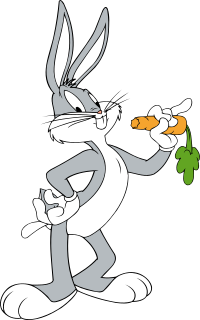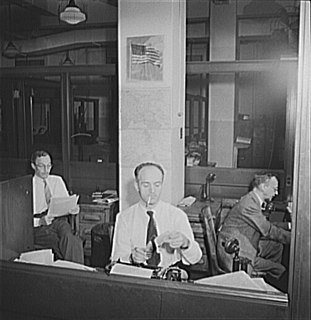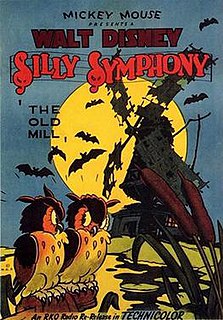
The New Yorker is an American weekly magazine featuring journalism, commentary, criticism, essays, fiction, satire, cartoons, and poetry. Started as a weekly in 1925, the magazine is now published 47 times annually, with five of these issues covering two-week spans. Although its reviews and events listings often focus on the cultural life of New York City, The New Yorker has a wide audience outside New York and is read internationally. It is well known for its illustrated and often topical covers, its commentaries on popular culture and eccentric Americana, its attention to modern fiction by the inclusion of short stories and literary reviews, its rigorous fact checking and copy editing, its journalism on politics and social issues, and its single-panel cartoons sprinkled throughout each issue.

Bugs Bunny is an animated cartoon character, created in the late 1930s by Leon Schlesinger Productions and voiced originally by Mel Blanc. Bugs is best known for his starring roles in the Looney Tunes and Merrie Melodies series of animated short films, produced by Warner Bros. Though a similar character debuted in the WB cartoon Porky's Hare Hunt (1938) and appeared in a few subsequent shorts, the definitive character of Bugs is widely credited to have made his debut in director Tex Avery's Oscar-nominated film A Wild Hare (1940).
The Powerpuff Girls is an American superhero animated television series created by animator Craig McCracken and produced by Hanna-Barbera for Cartoon Network. The show centers on Blossom, Bubbles, and Buttercup, three kindergarten-aged girls with superpowers. The girls all live in the fictional city of Townsville with their father and creator, a scientist named Professor Utonium, and are frequently called upon by the city's mayor to help fight nearby criminals and other enemies using their powers.

Mary Flannery O'Connor was an American novelist, short story writer and essayist. She wrote two novels and thirty-two short stories, as well as a number of reviews and commentaries.

Wile E. Coyote and the Road Runner are a duo of cartoon characters from the Looney Tunes and Merrie Melodies series of cartoons. In each episode, the cunning, insidious and constantly hungry Coyote repeatedly attempts to catch and subsequently eat the Road Runner, a fast-running ground bird, but is only one time successful. Instead of his animal instincts, the Coyote uses absurdly complex contraptions to try to catch his prey, which comically backfire, with the Coyote often getting injured in slapstick fashion. Many of the items for these contrivances are mail-ordered from a variety of companies that are all named Acme.

Silly Symphony is a series of 75 animated musical short films produced by Walt Disney Productions from 1929 to 1939. As their name implies, the Silly Symphonies were originally intended as whimsical accompaniments to pieces of music. As such, the films usually had independent continuity and did not feature continuing characters, unlike the Mickey Mouse shorts produced by Disney at the same time. The series is notable for its innovation with Technicolor and the multiplane motion picture camera, as well as its introduction of the character Donald Duck making his first appearance in the Silly Symphony cartoon The Wise Little Hen in 1934. Seven shorts won the Academy Award for Best Animated Short Film.

Terrytoons was an animation studio in New Rochelle, New York, that produced animated cartoons for theatrical release from 1928 to 1972. Terrytoons was founded by Paul Terry, Frank Moser, and Joseph Coffman, and operated out of the "K" Building in downtown New Rochelle. The studio created many cartoon characters including Mighty Mouse, Heckle and Jeckle, Gandy Goose, Sourpuss, Dinky Duck, Little Roquefort, the Terry Bears, and Luno; Terry's pre-existing character Farmer Al Falfa was also featured often in the series.

Courage the Cowardly Dog is an American animated horror comedy television series created by John R. Dilworth for Cartoon Network and the eighth of the Cartoon Cartoons. It was produced by Dilworth's animation studio, Stretch Films. The title character is a purple, anthropomorphic dog who lives with an elderly couple in a farmhouse in the middle of "Nowhere". In each episode, the trio are thrown into bizarre, frequently disturbing and often paranormal or supernatural-type misadventures. The series is known for its dark, surreal humor and atmosphere.

Print syndication distributes news articles, columns, political cartoons, comic strips and other features to newspapers, magazines and websites. The syndicates offer reprint rights and grant permissions to other parties for republishing content of which they own and/or represent copyrights. Other terms for the service include a newspaper syndicate, a press syndicate, and a feature syndicate.

Collier's was an American magazine, founded in 1888 by Peter Fenelon Collier. It was initially launched as Collier's Once a Week, then changed in 1895 to Collier's Weekly: An Illustrated Journal, and finally shortened in 1905 to Collier's: The National Weekly and eventually to simply Collier's. The magazine ceased publication with the issue dated for the week ending January 4, 1957, though a brief, failed attempt was made to revive the Collier's name with a new magazine in 2012.

The Fleischer Superman cartoons are a series of seventeen animated short films released in Technicolor by Paramount Pictures and based upon the comic book character Superman, making them his first animated appearance.

Tom and Jerry is an American animated franchise and series of comedy short films created in 1940 by William Hanna and Joseph Barbera. Best known for its 161 theatrical short films by Metro-Goldwyn-Mayer, the series centers on the rivalry between the titular characters of a cat named Tom and a mouse named Jerry. Many shorts also feature several recurring characters.

Barney Bear is an American series of animated cartoon short subjects produced by Metro-Goldwyn-Mayer cartoon studio. The title character is an anthropomorphic cartoon character, a sluggish, sleepy bear who often is in pursuit of nothing but peace and quiet. 26 Barney Bear cartoons were produced between 1939 and 1954.

The Old Mill is a 1937 Silly Symphonies cartoon produced by Walt Disney Productions, directed by Wilfred Jackson, scored by Leigh Harline, and released theatrically to theatres by RKO Radio Pictures on November 5, 1937. The film depicts the natural community of animals populating an old abandoned windmill in the country, and how they deal with a severe summer thunderstorm that nearly destroys their habitat. It incorporates the song "One Day When We Were Young" from Johann Strauss II's operetta The Gypsy Baron.
The Night of the Living Duck is a six-minute 1988 Merrie Melodies cartoon starring Daffy Duck, directed by Greg Ford and Terry Lennon. It was released to theatres as a part of Daffy Duck's Quackbusters on September 24, 1988 and is shown before the film in all of its releases.

Animaniacs is an American animated comedy musical television series created by Tom Ruegger for Fox Broadcasting Company's Fox Kids block, before moving to The WB in 1995 until the series ended in 1998 as part of its Kids' WB afternoon programming block. It is the second animated series produced by Steven Spielberg's Amblin Entertainment in association with Warner Bros. Animation, after Tiny Toon Adventures. It initially ran a total of 99 episodes, along with a feature-length film, Animaniacs: Wakko's Wish.
Harrison's Reports and Film Reviews is the 15-volume reprint of the complete run of the weekly magazine Harrison's Reports from its founding in 1919 to its demise in 1962. Volumes 1 through 14 are facsimile reprints of the more than 2,000 weekly issues. The reprints were edited by D. Richard Baer and published 1992-1995 by Hollywood Film Archive.
Fiddlin’ Around is a 1930 animated short film produced by Walt Disney Productions and released by Columbia Pictures as part of the Mickey Mouse film series. It was the sixteenth Mickey Mouse short to be produced, the first of that year.
Infinity Train is an American animated science fantasy-drama anthology television series created by Owen Dennis, previously a writer and storyboard artist on Regular Show. The pilot for the series was released by Cartoon Network on November 1, 2016, before being picked-up for a full miniseries due to positive reception, which premiered on Cartoon Network on August 5, 2019. After the conclusion of the first season, Cartoon Network announced that the series would continue as an anthology series. The second season debuted on Cartoon Network on January 6, 2020. The third season began airing on HBO Max on August 13, 2020, with ten episodes airing across three weeks.

Looney Tunes Cartoons is an American animated streaming television series developed by Peter Browngardt and produced by Warner Bros. Animation, based on the characters from Looney Tunes and Merrie Melodies. The series made its worldwide debut at the Annecy International Animated Film Festival on June 10, 2019, and premiered on HBO Max on May 27, 2020.














